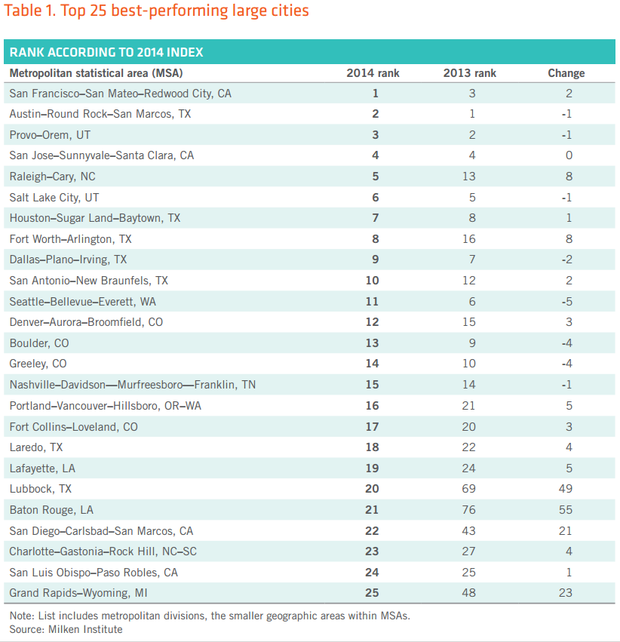Twin Citians have gotten pretty accustomed to seeing their fair metro at the top of national surveys on health, education, bike riding, and quality of life issues.
But the annual Milken Institute survey of best cities is a bucket of cold water.
The Minneapolis-St. Paul metropolitan area didn’t make the top 25. It didn’t make the top 30 (last year it finished 29 among big cities). It almost didn’t make the top 50. Minneapolis-St. Paul finished 45th, partly because there’s a dwindling high-tech economy here, according to the survey.
Curiously, of the six indicators that pushed Minneapolis St. Paul into the top 30 last year, only two have declined — five-year relative GDP growth and five-year job growth. But those are two pretty important items, and the other cities are picking up economic steam faster than MSP. Lincoln, Nebraska, for example, — a city that is not often mentioned in the same breath as Minneapolis St. Paul — is well ahead. Madison is #30.
The overall picture? All of the cities that those other surveys suggest are our equals are much higher on the list.
CityLab’s analysis of the report suggests that Minneapolis St. Paul and environs still have plenty going for them.
Economists have increasingly argued that talent and human capital are key drivers of regional economic performance. And Milken’s rankings show a reasonably close association between talent and economic performance. The Milken Index is positively associated with both the share of adults that are college grads (.32) and the share of the labor force made up of knowledge, professional, and creative workers (.23). The type of talent is even more interesting: The Milken Index is more closely associated with arts and cultural talent (.35) than science and tech talent (.30) or business professionals (.24). And for all the talk of how “eds and meds” can help spur development, the Milken Index is negatively associated with “eds and meds” occupations (-.17). This reflects what the venture capitalist Fred Wilson told me in an interview a while back: He sees tech startups shifting from their previous engineering and hardware orientation to a broader, more urban focus, where entrepreneurs have characteristics that are more similar to artists.
The best performing cities also tended to be more open and diverse. The Milken Index is positively associated with both the share of population that is foreign born (.26) and even more closely with the share that is gay and lesbian (.42).
Best performing cities are larger (.22) and denser (.26). The way people get to work also matters. The Milken Index is negatively associated with the share of commuters who drive to work alone (-.31) and positively associated with the share of take public transit to work (.26).
Duluth comes in at #114, an improvement from last year’s rating (#138). But that’s still closer to the bottom (currently occupied by Atlantic City) than the top.
Meanwhile, in the list of small cities, Fargo comes out #1. But, of course, the survey was calculated before the oil industry collapsed.
St. Cloud is #26 on the small cities list.

